Beryl
| Beryl | |
|---|---|
|
Three varieties of beryl: morganite, aquamarine and heliodor | |
| General | |
| Category | Cyclosilicate |
| Formula (repeating unit) | Be3Al2(Si O3)6 |
| Strunz classification | 9.CJ.05 |
| Crystal system | Hexagonal |
| Crystal class |
Dihexagonal dipyramidal (6/mmm) H-M symbol: (6/m 2/m 2/m) |
| Space group | P6/mcc |
| Unit cell | a = 9.21 Å, c = 9.19 Å; Z = 2 |
| Identification | |
| Formula mass | 537.50 g/mol |
| Color | Green, blue, yellow, colorless, pink and others |
| Crystal habit | Prismatic to tabular crystals; radial, columnar; granular to compact massive |
| Twinning | Rare |
| Cleavage | Imperfect on {0001} |
| Fracture | Conchoidal to irregular |
| Tenacity | Brittle |
| Mohs scale hardness | 7.5–8 |
| Luster | Vitreous to resinous |
| Streak | White |
| Diaphaneity | Transparent to translucent |
| Specific gravity | Average 2.76 |
| Optical properties | Uniaxial (-) |
| Refractive index |
nω = 1.564–1.595 nε = 1.568–1.602 |
| Birefringence | δ = 0.0040–0.0070 |
| Pleochroism | Weak to distinct |
| Ultraviolet fluorescence | None (some fracture filling materials used to improve emerald's clarity do fluoresce, but the stone itself does not). Morganite has weak violet fluorescence. |
| References | [1][2][3][4] |
Beryl is a mineral composed of beryllium aluminium cyclosilicate with the chemical formula Be3Al2(Si O3)6. Well-known varieties of beryl include emerald and aquamarine. Naturally occurring, hexagonal crystals of beryl can be up to several meters in size, but terminated crystals are relatively rare. Pure beryl is colorless, but it is frequently tinted by impurities; possible colors are green, blue, yellow, red, and white.
Etymology
The name "beryl" is derived (via Latin: beryllus, Old French: beryl, and Middle English: beril) from Greek βήρυλλος beryllos which referred to a "precious blue-green color-of-sea-water stone"; akin to Prakrit verulia, veluriya ("beryl").[5] The term was later adopted for the mineral beryl more exclusively.
When the first eyeglasses were constructed in 13th century Italy, the lenses were made of beryl (or of rock crystal) as glass could not be made clear enough. Consequently glasses were named Brillen in German [6] (bril in Dutch and Briller in Danish).
Deposits
Beryl of various colors is found most commonly in granitic pegmatites, but also occurs in mica schists in the Ural Mountains, and limestone in Colombia. Beryl is often associated with tin and tungsten ore bodies. Beryl is found in Europe in Norway, Austria, Germany, Sweden (especially morganite), Ireland and Russia, as well as Brazil, Colombia, Madagascar, Mozambique, Pakistan, South Africa, the United States, and Zambia. US beryl locations are in California, Colorado, Connecticut, Georgia, Idaho, Maine, New Hampshire, North Carolina, South Dakota and Utah.
New England's pegmatites have produced some of the largest beryls found, including one massive crystal from the Bumpus Quarry in Albany, Maine with dimensions 5.5 by 1.2 m (18.0 by 3.9 ft) with a mass of around 18 metric tons; it is New Hampshire's state mineral. As of 1999, the world's largest known naturally occurring crystal of any mineral is a crystal of beryl from Malakialina, Madagascar, 18 m (59 ft) long and 3.5 m (11 ft) in diameter, and weighing 380,000 kg (840,000 lb).[7]
Varieties
Aquamarine and maxixe
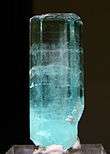

Aquamarine (from Latin: aqua marina, "water of the sea") is a blue or cyan variety of beryl. It occurs at most localities which yield ordinary beryl. The gem-gravel placer deposits of Sri Lanka contain aquamarine. Clear yellow beryl, such as that occurring in Brazil, is sometimes called aquamarine chrysolite. The deep blue version of aquamarine is called maxixe. Maxixe is commonly found in the country of Madagascar. Its color fades to white when exposed to sunlight or is subjected to heat treatment, though the color returns with irradiation.
The pale blue color of aquamarine is attributed to Fe2+. Fe3+ ions produce golden-yellow color, and when both Fe2+ and Fe3+ are present, the color is a darker blue as in maxixe. Decoloration of maxixe by light or heat thus may be due to the charge transfer between Fe3+ and Fe2+.[8][9][10][11] Dark-blue maxixe color can be produced in green, pink or yellow beryl by irradiating it with high-energy particles (gamma rays, neutrons or even X-rays).[12]
In the United States, aquamarines can be found at the summit of Mt. Antero in the Sawatch Range in central Colorado. In Wyoming, aquamarine has been discovered in the Big Horn Mountains, near Powder River Pass. Another location within the United States is the Sawtooth Range near Stanley, Idaho. Although the minerals are within a wilderness area which prevents collecting. In Brazil, there are mines in the states of Minas Gerais, Espírito Santo, and Bahia, and minorly in Rio Grande do Norte. The mines of Colombia, Zambia, Madagascar, Malawi, Tanzania and Kenya also produce aquamarine.
The largest aquamarine of gemstone quality ever mined was found in Marambaia, Minas Gerais, Brazil, in 1910. It weighed over 110 kg (240 lb), and its dimensions were 48.5 cm (19 in) long and 42 cm (17 in) in diameter.[13] The largest cut aquamarine gem is the Dom Pedro aquamarine, now housed in the Smithsonian Institution's National Museum of Natural History.[14]
Emerald
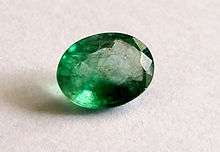
_15.jpg)
Emerald is green beryl, colored by trace amounts of chromium and sometimes vanadium.[8][15] The modern English word "emerald" comes via Middle English Emeraude, imported from Old French Ésmeraude and Medieval Latin Esmaraldus, from Latin smaragdus, from Greek σμάραγδος smaragdos, meaning ‘green gem’. Its original source could have been either a Semitic loan-word אזמרגד izmargad or the Sanskrit word मरकत marakata, both meaning ‘green’.[16] Most emeralds are highly included, so their brittleness (resistance to breakage) is classified as generally poor.
Emeralds in antiquity were mined by the Egyptians and in Austria, as well as Swat in northern Pakistan.[17] A rare type of emerald known as a trapiche emerald is occasionally found in the mines of Colombia. A trapiche emerald exhibits a "star" pattern; it has raylike spokes of dark carbon impurities that give the emerald a six-pointed radial pattern. It is named for the trapiche, a grinding wheel used to process sugarcane in the region. Colombian emeralds are generally the most prized due to their transparency and fire. Some of the rarest emeralds come from three main emerald mining areas in Colombia: Muzo, Coscuez, and Chivor. Fine emeralds are also found in other countries, such as Zambia, Brazil, Zimbabwe, Madagascar, Pakistan, India, Afghanistan and Russia. In the US, emeralds can be found in Hiddenite, North Carolina. In 1998, emeralds were discovered in the Yukon.
Emerald is a rare and valuable gemstone and, as such, it has provided the incentive for developing synthetic emeralds. Both hydrothermal[18] and flux-growth synthetics have been produced. The first commercially successful emerald synthesis process was that of Carroll Chatham.[19] The other large producer of flux emeralds was Pierre Gilson Sr., which has been on the market since 1964. Gilson's emeralds are usually grown on natural colorless beryl seeds which become coated on both sides. Growth occurs at the rate of 1 mm per month, a typical seven-month growth run producing emerald crystals of 7 mm of thickness.[20] The green color of emeralds is widely attributed to presence of Cr3+ ions.[9][10][11] Intensely green beryls from Brazil, Zimbabwe and elsewhere in which the color is attributed to vanadium have also been sold and certified as emeralds.[21][22][23]
Golden beryl and heliodor
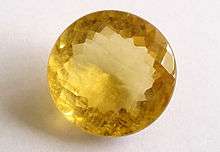


Golden beryl can range in colors from pale yellow to a brilliant gold. Unlike emerald, golden beryl generally has very few flaws. The term "golden beryl" is sometimes synonymous with heliodor (from Greek hēlios – ἥλιος "sun" + dōron – δῶρον "gift") but golden beryl refers to pure yellow or golden yellow shades, while heliodor refers to the greenish-yellow shades. The golden yellow color is attributed to Fe3+ ions.[8][9] Both golden beryl and heliodor are used as gems. Probably the largest cut golden beryl is the flawless 2054-carat stone on display in the Hall of Gems, Washington, D.C., United States.[24]
Goshenite
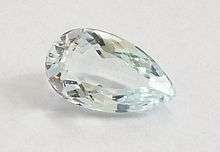

Colorless beryl is called goshenite. The name originates from Goshen, Massachusetts, where it was originally discovered. Since all these color varieties are caused by impurities and pure beryl is colorless, it might be tempting to assume that goshenite is the purest variety of beryl. However, there are several elements that can act as inhibitors to color in beryl and so this assumption may not always be true. The name goshenite has been said to be on its way to extinction and yet it is still commonly used in the gemstone markets. Goshenite is found to some extent in almost all beryl localities. In the past, goshenite was used for manufacturing eyeglasses and lenses owing to its transparency. Nowadays, it is most commonly used for gemstone purposes and also considered as a source of beryllium.[25][26]
The gem value of goshenite is relatively low. However, goshenite can be colored yellow, green, pink, blue and in intermediate colors by irradiating it with high-energy particles. The resulting color depends on the content of Ca, Sc, Ti, V, Fe, and Co impurities.[9]
Morganite
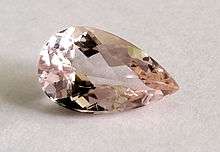
.jpg)
Morganite, also known as "pink beryl", "rose beryl", "pink emerald", and "cesian (or caesian) beryl", is a rare light pink to rose-colored gem-quality variety of beryl. Orange/yellow varieties of morganite can also be found, and color banding is common. It can be routinely heat treated to remove patches of yellow and is occasionally treated by irradiation to improve its color. The pink color of morganite is attributed to Mn2+ ions.[8]
Pink beryl of fine color and good sizes was first discovered on an island on the coast of Madagascar in 1910.[27] It was also known, with other gemstone minerals, such as tourmaline and kunzite, at Pala, California. In December 1910, the New York Academy of Sciences named the pink variety of beryl "morganite" after financier J. P. Morgan.[27]
On October 7, 1989, one of the largest gem morganite specimens ever uncovered, eventually called "The Rose of Maine," was found at the Bennett Quarry in Buckfield, Maine, US.[28] The crystal, originally somewhat orange in hue, was 23 cm (9 in) long and about 30 cm (12 in) across, and weighed (along with its matrix) just over 50 pounds (23 kg).[29]
Red beryl
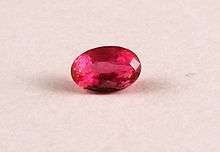
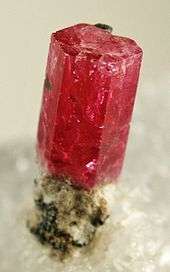
Red beryl (formerly known as "bixbite" and marketed as "red emerald" or "scarlet emerald") is a red variety of beryl. It was first described in 1904 for an occurrence, its type locality, at Maynard's Claim (Pismire Knolls), Thomas Range, Juab County, Utah.[30][31] The old synonym "bixbite" is deprecated from the CIBJO, because of the risk of confusion with the mineral bixbyite (also named after the mineralogist Maynard Bixby). The dark red color is attributed to Mn3+ ions.[8]
Red beryl is very rare and has been reported only from a handful of locations: Wah Wah Mountains, Beaver County, Utah; Paramount Canyon and Round Mountain, Sierra County, New Mexico, although the latter locality does not often produce gem grade stones;[30] and Juab County, Utah. The greatest concentration of gem-grade red beryl comes from the Ruby-Violet Claim in the Wah Wah Mountains of the Thomas range of mid-western Utah, discovered in 1958 by Lamar Hodges, of Fillmore, Utah, while he was prospecting for uranium.[32] Red beryl has been known to be confused with pezzottaite, a caesium analog of beryl, that has been found in Madagascar and more recently Afghanistan; cut gems of the two varieties can be distinguished from their difference in refractive index, and rough crystals can be easily distinguished by differing crystal systems (pezzottaite trigonal, red beryl hexagonal). Synthetic red beryl is also produced.[33] Like emerald and unlike most other varieties of beryl, red beryl is usually highly included.
While gem beryls are ordinarily found in pegmatites and certain metamorphic stones, red beryl occurs in topaz-bearing rhyolites. It is formed by crystallizing under low pressure and high temperature from a pneumatolytic phase along fractures or within near-surface miarolitic cavities of the rhyolite. Associated minerals include bixbyite, quartz, orthoclase, topaz, spessartine, pseudobrookite and hematite.[34]
See also
References
- ↑ Beryl mineral information and data, Mindat
- ↑ Beryl Webmineral
- ↑ Handbook of Mineralogy
- ↑ Schumann, Walter, 2013, Gemstones of the World, 5th ed., ISBN 1-454-90953-6
- ↑ "beryl". Merriam-Webster Dictionary. Merriam-Webster, Inc. Retrieved January 27, 2014.
- ↑ Kluge, Alexander, Etymologisches Wörterbuch der deutschen Sprache. 21 ed. 1975.
- ↑ G. Cressey and I. F. Mercer, (1999) Crystals, London, Natural History Museum, page 58
- 1 2 3 4 5 "Color in the Beryl group". Retrieved 2009-06-06.
- 1 2 3 4 Ibragimova, E. M.; Mukhamedshina, N. M.; Islamov, A. Kh. (2009). "Correlations between admixtures and color centers created upon irradiation of natural beryl crystals". Inorganic Materials. 45 (2): 162. doi:10.1134/S0020168509020101.
- 1 2 Viana, R. R.; Da Costa, G. M.; De Grave, E.; Stern, W. B.; Jordt-Evangelista, H. (2002). "Characterization of beryl (aquamarine variety) by Mössbauer spectroscopy". Physics and Chemistry of Minerals. 29: 78. Bibcode:2002PCM....29...78V. doi:10.1007/s002690100210.
- 1 2 Blak, Ana Regina; Isotani, Sadao; Watanabe, Shigueo (1983). "Optical absorption and electron spin resonance in blue and green natural beryl: A reply". Physics and Chemistry of Minerals. 9 (6): 279. Bibcode:1983PCM.....9..279B. doi:10.1007/BF00309581.
- ↑ K. Nassau (1976). "The deep blue Maxixe-type color center in beryl" (PDF). American Mineralogist. 61: 100.
- ↑ Schumann, Walter (2009). Gemstones of the World. Sterling Publishing Co. p. 110. ISBN 978-1-4027-6829-3.
- ↑ Vastag, Brian (2 December 2012). "The Dom Pedro aquamarine's long and winding path to the Smithsonian". The Washington Post. Retrieved 7 December 2012.
- ↑ Hurlbut, Cornelius S. Jr & Kammerling, Robert C. (1991). Gemology. New York: John Wiley & Sons. p. 203. ISBN 0-471-42224-X.
- ↑ Fernie M.D., W.T. (1906). Precious Stones for Curative Wear. John Wright. & Co.
- ↑ Giuliani, G.; Chaussidon, M; Schubnel, HJ; Piat, DH; Rollion-Bard, C; France-Lanord, C; Giard, D; De Narvaez, D; Rondeau, B (2000). "Oxygen Isotopes and Emerald Trade Routes Since Antiquity". Science. 287 (5453): 631–3. Bibcode:2000Sci...287..631G. doi:10.1126/science.287.5453.631. PMID 10649992.
- ↑ Hosaka, M (1991). "Hydrothermal growth of gem stones and their characterization". Progress in Crystal Growth and Characterization of Materials. 21: 71. doi:10.1016/0960-8974(91)90008-Z.
- ↑ Gemology Project
- ↑ Nassau, K., 1980, Gems Made By Man, Gemological Institute of America, ISBN 0-87311-016-1
- ↑ Thomas, Arthur (2008). Gemstones: Properties, Identification and Use. London: New Holland. pp. 77–78. ISBN 978-1-84537-602-4.
- ↑ Behmenburg, Christa; et al. (January 2002). Giuliani, Gaston; et al., eds. Emeralds of the World. extraLapis. 2. East Hampton, Connecticut: Lapis International. pp. 75–77. ISBN 0971537119.
- ↑ Deer, W.A.; et al. (1997). Disilicates and Ring Silicates. Rock-forming Minerals. 1B (2 ed.). Bath: Geological Society of London. pp. 393–394. ISBN 1897799896.
- ↑ Arthur Thomas (2007). Gemstones. New Holland Publishers. p. 77. ISBN 1-84537-602-1.
- ↑ "Goshenite, the colorless variety of beryl". Retrieved 2009-06-06.
- ↑ "Goshenite gem". Retrieved 2009-06-06.
- 1 2 "GEM NAMED FOR MORGAN.; Newly Discovered Pink Beryl Is to be Known as Morganite". The New York Times. 1910-12-06.
- ↑ Harrison, Donald K.; Anderson, Walter; Foley, Michael E. (1990). "Maine". Minerals yearbook 1990. 2. US Bureau of Mines. pp. 234–239. ISBN 0-16-038183-5.
- ↑ The Rose of Maine, image, The Rose of Maine at the site of its discovery
- 1 2 MinDat – Red beryl
- ↑ Carl Ege, Utah Geological Survey
- ↑ "Red Emerald History". 2007-11-21. Retrieved 2007-11-21.
- ↑ "Bixbite" – The Gemstone List
- ↑ Carl Ege. "What gemstone is found in Utah that is rarer than diamond and more valuable than gold?". Utah Geological Survey. Retrieved July 2, 2011.
- Hurlbut, Cornelius S.; Klein, Cornelis, 1985, Manual of Mineralogy, 20th ed., John Wiley and Sons, New York ISBN 0-471-80580-7
- Sinkankas, John, 1994, Emerald & Other Beryls, Geoscience Press, ISBN 0-8019-7114-4
External links
 The dictionary definition of beryl at Wiktionary
The dictionary definition of beryl at Wiktionary Media related to Aquamarine at Wikimedia Commons
Media related to Aquamarine at Wikimedia Commons Media related to Beryl at Wikimedia Commons
Media related to Beryl at Wikimedia Commons Media related to Emeralds at Wikimedia Commons
Media related to Emeralds at Wikimedia Commons Media related to Goshenite at Wikimedia Commons
Media related to Goshenite at Wikimedia Commons Media related to Golden beryl at Wikimedia Commons
Media related to Golden beryl at Wikimedia Commons Media related to Morganite at Wikimedia Commons
Media related to Morganite at Wikimedia Commons Media related to Red beryl at Wikimedia Commons
Media related to Red beryl at Wikimedia Commons "Beryl". The American Cyclopædia. 1879.
"Beryl". The American Cyclopædia. 1879.
